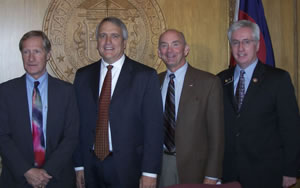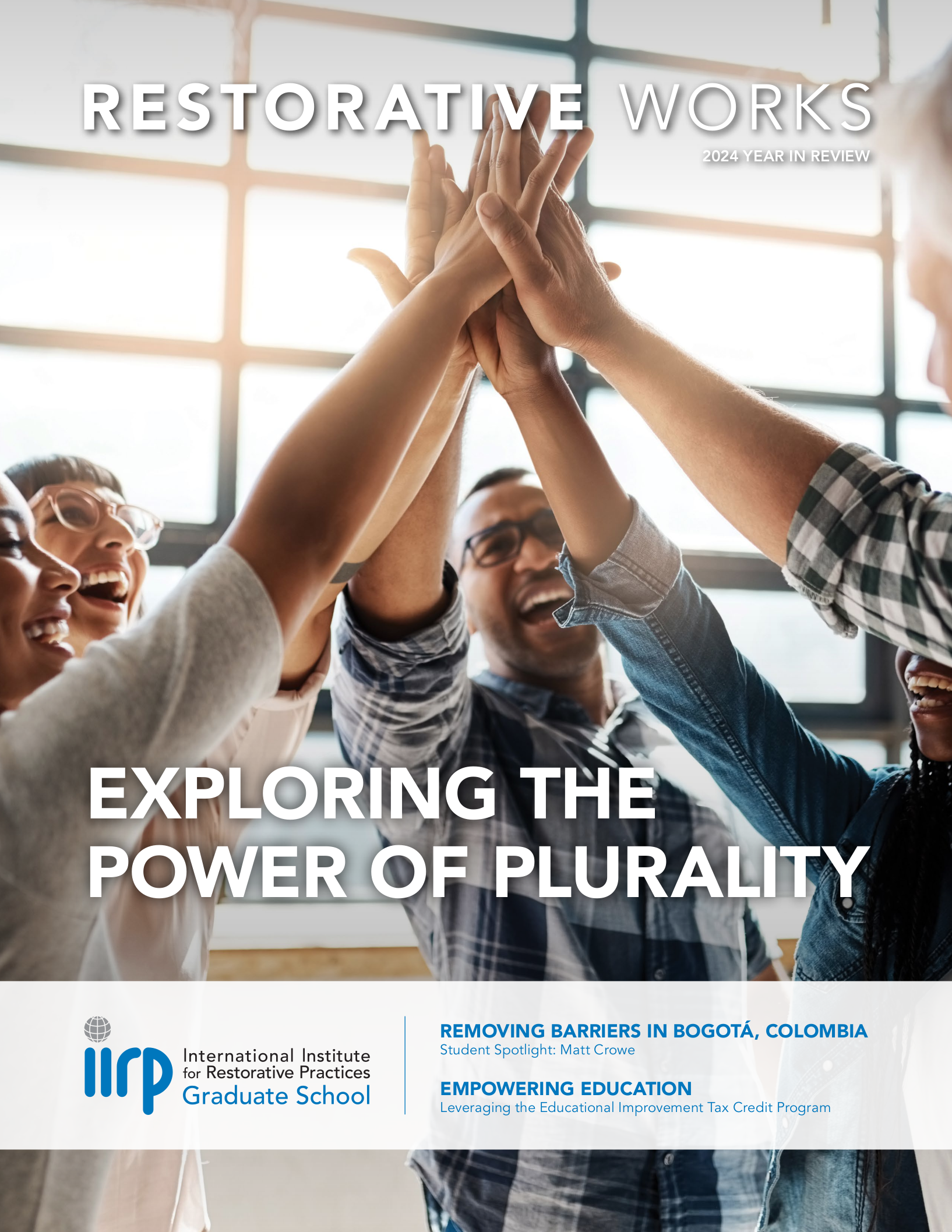News & Announcements
- Details
- Written by Paul McCold
Click here to view the original findings for 1999-2001.
Click here to view the the second study, with findings for 2001-2003
This paper reports on the latest (third) phase of an ongoing study, in progress since 1999, which highlights decreases in offending among 3,928 youth discharged from Community Service Foundation and Buxmont Academy's (CSF Buxmont's) restorative programs. The results of all three studies show a dramatic decline in offending rates, achieved through the systematic use of restorative practices, which diminishes only modestly over time.
CSF Buxmont Client Population
A total of 2,151 students were discharged from CSF Buxmont programs during the three school years ending in August 2004, 2005 and 2006. Students were referred from schools (SC), children and youth services (C&Y) and juvenile probation (JP). Characteristics of these CSF Buxmont clients by the referral source are shown in Table 1 *Most (68%) are boys, but a majority of youth referred from C&Y are girls (56%). Overall, most referred youth are white (74%), but a large proportion of C&Y referrals are black (27%) or Hispanic (14%).
- Details
- Written by Joshua Wachtel
 (L-R) Colorado youth RJ bill author Pete Lee, Governor Bill Ritter, Representative Michael Merrifield and Senator John Morse, at the bill-signing ceremony
(L-R) Colorado youth RJ bill author Pete Lee, Governor Bill Ritter, Representative Michael Merrifield and Senator John Morse, at the bill-signing ceremonyOn March 31, 2008, Colorado Governor Bill Ritter signed into law House Bill 08-1117, which authorizes the use of restorative justice (RJ) in the state’s Children’s Code and gives Colorado the legislative edge among states that sanction the use of RJ. The bill passed 63-1 in the House and 33-0 in the Senate.
Upon signing the bill, Governor Ritter said, “By making juvenile offenders take responsibility for the consequences of their actions, we can teach them that the decisions they make, both good and bad, will affect the course of their life. Repairing the harm that someone has caused can be the thing that matters most in the criminal justice system.” Added Ritter, “As a former prosecutor, I’ve seen too many people start out committing minor crimes as juveniles and escalate to committing serious crimes as adults. We must do everything we can to intervene early and break this cycle.”
The law, sponsored by State Representative Michael Merrifield in the House and by State Senator John Morse in the Senate, gives judges the authority to offer accused young offenders the legal option to voluntarily participate in RJ processes. The law encodes a well-defined definition of restorative justice and practices:
- Details
- Written by Brenda Lange
Matt sat quietly in the small conference room, recounting a recent experience that was a watershed in his young life. Matt has attended the Community Service Foundation/Buxmont Academy (CSF Buxmont) school, in Trevose, Pennsylvania, USA, since October 2006, where emphasis on community problem-solving and support was key to his handling of this very challenging situation and his subsequent personal growth.
 Dave provides support for his friend and fellow-CSF Buxmont student, Matt.“I’ve been through some hard times,” the 18-year-old began. “I’ve been arrested for possession of marijuana, and I was taking OxyContin [a prescription narcotic pain medication] for a year and a half. I finally realized that I have a family that cares and I went into outpatient [treatment], then inpatient, and I’ve been clean since.”
Dave provides support for his friend and fellow-CSF Buxmont student, Matt.“I’ve been through some hard times,” the 18-year-old began. “I’ve been arrested for possession of marijuana, and I was taking OxyContin [a prescription narcotic pain medication] for a year and a half. I finally realized that I have a family that cares and I went into outpatient [treatment], then inpatient, and I’ve been clean since.”
A shadow crossed Matt’s face as he talked about last month’s traumatic incident, when his 30-year-old brother’s liver was failing from alcohol abuse. He wasn’t expected to live; in fact, he was given last rites. “I was there, and it scared the hell out of me,” said Matt.
- Details
- Written by Joshua Wachtel
 Ping Yi Secondary School students participate in a restorative circle.In 2005, Ping Yi Secondary School in Singapore was chosen by the Ministry of Education as one of four pilot schools to receive training and begin using restorative practices (RP). The school is now entering its fourth year of the pilot and is working to train teachers and administrators to use RP reactively in cases of discipline, but also proactively to create a restorative school culture.
Ping Yi Secondary School students participate in a restorative circle.In 2005, Ping Yi Secondary School in Singapore was chosen by the Ministry of Education as one of four pilot schools to receive training and begin using restorative practices (RP). The school is now entering its fourth year of the pilot and is working to train teachers and administrators to use RP reactively in cases of discipline, but also proactively to create a restorative school culture.
Singapore is a prosperous industrial nation and center of trade for south Asia. The city sports beautiful high-rise office buildings as well as successful factories. The small island country about the size of Chicago (one of the few city-states in the modern world) has a population of over four million and sits just off the coast of Malaysia a few short miles north of the equator. The population is comprised of about 75 percent Chinese, 14 percent Malays, 9 percent Indians, and the rest Eurasians and other groups.
- Details
- Written by IIRP
The show presents views from criminologists Lawrence Sherman, Kathleen Daly andChris Cunneen, and CEO of the Centre for Restorative Justice, SouthAustralia, Leigh Garrett.
- Details
- Written by Laura Mirsky
[The goals and philosophy of restorative practices are, of course, consistent with those of programs promoting social and emotional learning. These findings should therefore buoy the confidence of those working in schools to enhance social and emotional learning by means of restorative practices.]
The study showed that students who participate in school-based programs that focus on social and emotional learning, compared to students who do not, improve significantly in terms of social and emotional skills; attitudes about themselves, others and school; social and classroom behavior; emotional distress such as stress, anxiety and depression; achievement test scores (11 percentage points higher); and school grades.
- Details
- Written by Lynn M. Welden
This article by Lynn M. Welden talks about how restorative practices is spreading in schools throughout New South Wales and South Australia, aided by multi-school summits or forums, where staff meet to share their implementation experiences.
- Details
- Written by Lynn M. Welden
 West Beach Public School pupils and teacher Rosemary Griffin participate in SW Metro District’s Restorative Directions Day, engaging in a circle process.Two Australian educators are making an important difference in the emotional and academic vitality of the schools in their regions. Lyn Doppler has been principal of the award-winning Rozelle Public School in Sydney, New South Wales, since 2002. Lesley Oliver is manager of Student Inclusion and Wellbeing for the government of South Australia’s Department of Education and Children’s Services (DECS), representing the South West (SW) Metro District of Adelaide. Each has been recognized for her leadership role in embedding restorative practices in Australian schools.
West Beach Public School pupils and teacher Rosemary Griffin participate in SW Metro District’s Restorative Directions Day, engaging in a circle process.Two Australian educators are making an important difference in the emotional and academic vitality of the schools in their regions. Lyn Doppler has been principal of the award-winning Rozelle Public School in Sydney, New South Wales, since 2002. Lesley Oliver is manager of Student Inclusion and Wellbeing for the government of South Australia’s Department of Education and Children’s Services (DECS), representing the South West (SW) Metro District of Adelaide. Each has been recognized for her leadership role in embedding restorative practices in Australian schools.
Restorative practices (RP) in schools is based on the principles of restorative justice. Police officer Terry O’Connell was one of the restorative justice pioneers in Australia in the early 1990s. Currently director of Real Justice Australia (an affiliate of the International Institute for Restorative Practices), Terry O’Connell found that bringing offenders and victims and their supporters together in a face-to-face meeting had a beneficial effect on the healing process. His “scripted model,” used in facilitating such restorative conferences, has had enormous impact on criminal justice throughout the world.
- Details
- Written by Laura Mirsky
 A classroom at the first CSF school, in Sellersville, Pennsylvania, USAThirty years ago, in December 1977, the Community Service Foundation (CSF) welcomed Jimmy*, its first client. Bucks County Juvenile Court (Pennsylvania, USA), had referred Jimmy, 15 and just released from juvenile detention, to CSF as a test case. A brain-damage victim—probably at the hands of his father—Jimmy liked to steal large construction vehicles and drive them around.
A classroom at the first CSF school, in Sellersville, Pennsylvania, USAThirty years ago, in December 1977, the Community Service Foundation (CSF) welcomed Jimmy*, its first client. Bucks County Juvenile Court (Pennsylvania, USA), had referred Jimmy, 15 and just released from juvenile detention, to CSF as a test case. A brain-damage victim—probably at the hands of his father—Jimmy liked to steal large construction vehicles and drive them around.Ted Wachtel, now president of the International Institute for Restorative Practices (IIRP), had been a public high school teacher. Frustrated by the way he saw “difficult” youth being treated, he left his job and, in March 1977, obtained a private school license for CSF. By December, CSF had a staff—Ted and two short-term employees—and a home—a room in a local church. Jimmy spent nights with friends of the Wachtels.
- Details
- Written by Rodney Skager
Rodney Skager is Professor Emeritus, Graduate School of Education and Information Studies, University of California, Los Angeles, Co-Director of the California Student Survey sponsored by the Office of the California Attorney General, and consultant to the Drug Policy Alliance. This paper was originally published in October 2007 as “More Effective and Humane Youth Policy Starts by Treating Youth with Respect,” in D.L. White, B.C. Glenn, and A. Wimes (eds.), Proceedings of Persistently Safe Schools: The 2007 National Conference on Safe Schools, pp. 243-250, Washington, DC: Hamilton Fish Institute, The George Washington University.
Adults often perceive teen-age behavior as oppositional. In this they are right. The question is: oppositional to what and why?
The “what” part is obvious. Opposition takes the form of doing things that adults forbid or discourage. This includes joining gangs, using drugs or getting drunk, having sex, truancy and damaging school property, physical risk-taking, bizarre dress, tattoos and piercing, adult-toxic taste in entertainment, disrespectful behavior to adult authority, and so on. These choices and associated behaviors are expressions of something larger than individual resentment. They are the product of a teen-age subculture that was visible by the mid-20th century and has developed spectacularly since that time.

Restorative Works Year in Review 2024 (PDF)
All our donors are acknowledged annually in Restorative Works.
